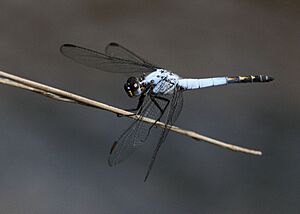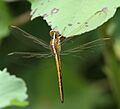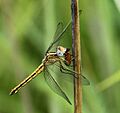Nesciothemis farinosa facts for kids
Quick facts for kids Nesciothemis farinosa |
|
|---|---|
 |
|
| Conservation status | |
| Scientific classification |
The Nesciothemis farinosa, also known as the Eastern Blacktail, is a type of dragonfly. It belongs to the Libellulidae family, which is a large group of dragonflies. These amazing insects are known for their beautiful wings and quick flight.
Contents
What's in a Name? Common Names of the Eastern Blacktail
This dragonfly has several cool nicknames! People often call it the Eastern Blacktail, which is its most common name. You might also hear it called the Black-tailed Skimmer. But be careful! There's another dragonfly with a similar name, the Orthetrum cancellatum, found in Europe and Asia. Other names for Nesciothemis farinosa include Black-tailed Dancer, Black-tailed False-skimmer, and Common Blacktail.
Where Does the Eastern Blacktail Live?
Its Home Across Africa
The Eastern Blacktail dragonfly lives in many countries across Africa. You can find it in places like Angola, Botswana, the Democratic Republic of the Congo, Egypt, Ethiopia, Kenya, Liberia, Malawi, Mozambique, Namibia, Nigeria, Sierra Leone, South Africa, Sudan, Tanzania, Uganda, Zambia, and Zimbabwe. It's found in a wide area, showing it's quite adaptable!
Is It Endangered?
Good news! The Eastern Blacktail is listed as 'Least Concern' by the IUCN (International Union for Conservation of Nature). This means it's not currently in danger of disappearing. There are still many of them flying around!
What Kind of Places Does It Like?
The Eastern Blacktail dragonfly enjoys many different types of natural habitats. It likes warm, wet lowland forests and dry savanna areas. You can also find it in moist savannas and different kinds of shrubland, both dry and moist.
These dragonflies are often found near water. They live by rivers, even rivers that sometimes dry up. They also like swamps, freshwater lakes (including those that are sometimes dry), and freshwater marshes. They can even be found in marshes that dry up from time to time. This shows they can live in many different watery environments!
Gallery














